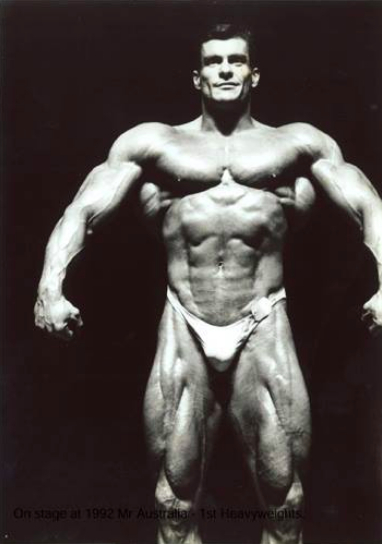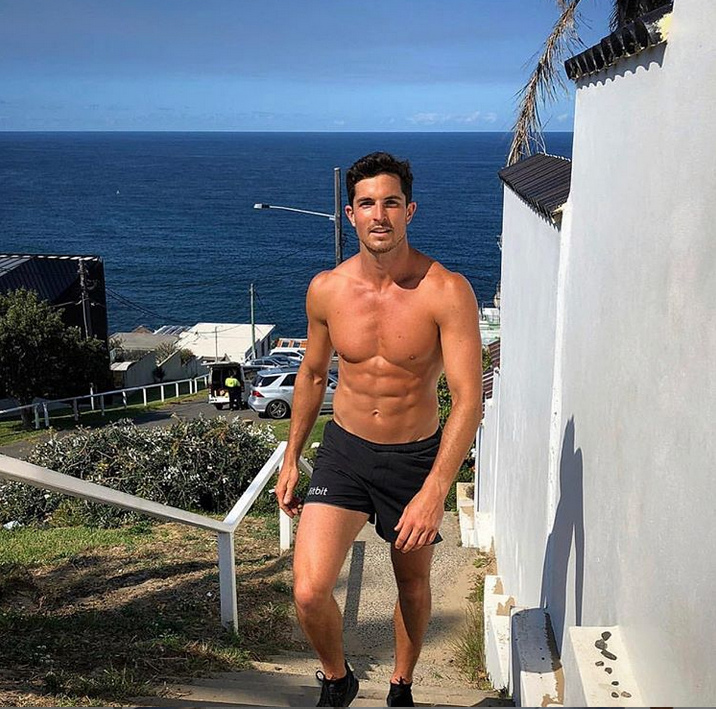Lurking beneath James Newbury’s blond dreadlocks is a mighty athlete. A national CrossFit champion who’s been named “Australia’s fittest man” four times, Newbury finished fifth in last year’s world CrossFit Games. Years of testing himself against psychotically tough competitors mean that he’s not easily wowed by mortal feats of physical prowess. But the 29-year-old still remembers one man whose pound-for-pound strength left a gobsmacking impression.
Ten years ago, Newbury was pushing to become a semi-pro rugby league player in Brisbane. One of his teammates in the South Brisbane Magpies Under-20s was Toby Hook, a guy Newbury had known from back home in Adelaide. But something had happened – Hook had undergone a dynamic transformation. “When I met him again, Toby looked a lot bigger and a lot more shredded – his shoulders were huge,” Newbury recalls. “I was amazed at how strong his upper body was in comparison to mine. I used to crush myself in the gym – a lot more than he did – but he was always so much stronger.”
Hook weighed around 84kg but could comfortably bench-press 160kg. He could also bang out 30 strict handstand push-ups with ease. “He’d just got much stronger than everyone else in the team.”
The secret of the man’s power wasn’t down to steroids, plyometrics or drop-sets. His mythical strength, in fact, stemmed from a more prosaic source: Hook had started working as a bricklayer. “He put it down to constantly lifting and moving stuff around throughout his day,” Newbury says. “Lifting the bricks gave him really good grip strength while picking up wheelbarrows gave him a good deadlift, too.”
Newbury mentions his old teammate not to extol the honest virtues of manual labour, but because Hook is a real-life demonstration of a training methodology that’s gaining momentum. It can make you stronger, healthier and more mobile. It doesn’t require lengthy gym sessions and is almost purpose-built for the time-poor dad as you can easily fit it in around small kids. The best part in these crazy days of COVID – you can do it in lockdown with minimal equipment, too.
Commonly known as “exercise snacking”, the idea behind it is simple. Instead of condensing your training into a single session, you chunk it up into “microworkouts” that are drip-fed throughout the course of your day.
At regular intervals – perhaps every 30 or 60 minutes – you might drop down and punch out a quick set of, say, push-ups and mountain-climbers. Taken as a one-off, this workload is fairly painless and can be completed in under two minutes. Yet by the end of the working day, if you’ve repeated the microworkout a bunch of times you can accumulate some serious volume.
THE RESEARCH
Exercise scientists are now unlocking the benefits of microworkouts. Last year, Canadian researchers at McMaster University completed a study where they recruited 24 healthy but inactive college students. Turning up at the physiology building’s stairwell, the students were told to hurry up three flights of stairs – 60 steps – as quickly as they could, one step at a time, in ascents that lasted about 20 seconds. That was the sum total of the workout. The students performed this exercise snack three times a day for six weeks. By the end, they’d increased their aerobic fitness by about 5 per cent and also boosted their leg power.
These positive findings were consistent with another study from Bath University in the UK that focused on older adults aged between 65 and 80. Tasked with doing simple exercise snacks every day over the course of a month, the volunteers’ muscle strength improved by 5 per cent, and thigh muscle size increased by 2 per cent
That’s all positive news. But while the results of these studies were heartening, they still focused on idle students and doddering pensioners. What about the benefits of microworkouts for more active men?
THE BODYBUILDER
At the beginning of the 1990s, Paul Haslam was “living the bodybuilder’s dream”. A Herculean specimen with unfeasibly large shoulders, Haslam was running a gym in Belmont North, near Newcastle, that was located in a shopping centre giving him easy access to a butcher, greengrocer, bakery and supermarket. With all his immediate needs catered for, Haslam could devote single-minded focus to his training goals. Having represented Australia in a series of international bodybuilding contests, he was now targeting the national heavyweight title. There was just one problem: the size of his calves. Whatever Haslam tried, he just couldn’t grow them any bigger.
So Haslam began to supplement his already intensive training with microworkouts. He started to perform one set of 15 to 20 standing calf raises and a similar set of seated calf raises “on the hour, every hour for 12 hours per day.”
The additional effort paid off. Haslam promptly scooped the title of Mr Australia for two years in a row. And while he doesn’t believe exercise snacking is necessarily better than conventional training, Haslam is convinced that it can build muscle. “High volumes with lighter loads can still elicit a hypertrophic response that assists in muscle gain,” the father-of-two insists.

Anyone who doubts whether a “little and often” approach can add size, he adds, should take one look at Rafael Nadal’s left arm. Moreover, if you’re stuck in a training plateau, exercise snacking could help you burst through it as the sheer volume of reps will shock your body to respond. “For many, microworkouts will be a novel stimulus and that in itself will be enough to promote new gains,” Haslam says.
One caveat if you’re trying to build muscle – exercise snacking doesn’t lend itself to going heavy. Training closer to failure is proven to result in better gains. But in a microworkout you’re unlikely to attempt anything close to your max as, to avoid injury, tackling heavier loads demands a thorough warm-up. Prepping for 15-minute before confronting a big lift simply doesn’t make sense if you’re planning to repeat your snack every hour throughout your working day.
Yet the disadvantage of lighter loads can be offset by volume. “Many studies have shown that, if the intensity is the same, volume delivered over a longer timeframe will elicit a very similar response (to heavier weights),” Haslam says.
There are other potential benefits, too. When it comes to muscle-building programs, one of the all-time classics is German volume training (GVT) where you complete 10 sets of 10 reps with the same weight. Yet the physical intensity of GVT means that it’s only recommended as a short-term program. The beauty of exercise snacking, Haslam suggests, is that it can help you achieve similarly high volumes in a way that you can maintain without as much soreness and central nervous system damage. “If a microworkout program is designed well – for example, rotating exercises – it can be very sustainable.”
Can microworkouts help you lose body fat? The bottom line is that, if you burn more kilojoules than you consume, you’ll fast-track your route to visible abs. Exercise snacking could help you create that deficit – particularly if tacked onto a broader training regimen. “If your daily total energy expenditure is increased through the microworkout system, then yes, they can lead to decreased body-fat levels,” Haslam says.
Admittedly, there are drawbacks. Compared to working out in a well-equipped gym, there’ll probably be a limited number of exercises that you can perform. More importantly, you’ve still got to actually do the work. You might find it harder to knuckle down to repeated sets rather than dedicate the time to a single session (multiple workouts = multiple potential distractions). Nevertheless, it’s worth giving a go as the benefits might amount to a lot more than adding an extra inch to your arms.
THE HEALTH BENEFITS
Working from his Bondi apartment, Drew Harrisberg handles most of his clients over video conferencing. But after each appointment, the exercise physiologist steps away from his laptop and drops to his living-room floor. Methodically, he performs 12 push-ups, focusing on text-book form and slow momentum. From there, he goes straight into 12 deep squats, lowering until his hamstrings rest on top of his calves, before snapping out 12 quick-fire burpees. “That’s my exercise snack,” Harrisberg says. “I see how many times over the day I can accumulate that.”

As you’d expect from someone with a background in sports science, the composition of these moves is not accidental. Just as from a dietary perspective, the ideal snack would combine all of your primary macros, Harrisberg deliberately balances moves with different benefits. The push-up delivers an upper-body muscular contraction, the deep squat helps with hip and ankle mobility, while the burpees lift his heart-rate, work his posterior chain and lengthen his hamstrings. But the reason Harrisberg religiously performs what he’s come to call “Drew’s Daily Dozen”, is not to burn fat or build muscle. He executes them to safeguard his health.
Despite being a healthy, active guy, Harrisberg was diagnosed with Type 1 diabetes at the age of 22. Monitoring his condition to try and stay on top of it, he made a discovery. “What I found was that the more time that I spend sitting and literally not moving at all, the worst my blood glucose control became.”
Punctuating his desk time with any sort of movement – from a two-minute walk to 10 bodyweight squats – made a discernible difference.
Research from New Zealand shows that Harrisberg’s finding wasn’t a one-off. Microworkouts do indeed help control blood sugar in people with insulin resistance more effectively than one daily 30-minute session. But for Harrisberg, the implications go way beyond diabetes. Microworkouts, he insists, allow you to weave exercise into the fabric of your day in a far more effective and holistic way.
Even if you train on a daily basis, think about the rest of your waking hours, he urges. For most of us desk-jockeys, that remaining time will be scarily inactive beyond the occasional amble to stick on the kettle. “If you’re sitting on your ass and you think that one hour in the gym is enough to mitigate the effects of all that sitting then you’re dreaming,” he says.
Harrisberg points out that, in the world’s longevity hotspots like Okinawa and Sardinia, structured exercise is rare. The inhabitants are not lyra-clad gym-rats doing CrossFit, HIIT or Pilates. They’re simply living in environments that promote regular movement throughout the course of the day. “Their exercise is carrying groceries, gardening, walking up hills, constantly moving, never sitting down too long,” Harrisberg says. “That incidental physical activity adds up and they’re living proof that you don’t have to spend an hour in the gym every day to be lean and healthy.”
Microworkouts may sound like a sexy new form of training. But the fundamental idea of adding more exercise to your day in bite-sized chunks is, in fact, what we’re physically evolved to do. Exercise snacking offers a fresh way to integrate more movement into your daily life. Yes, it’ll improve your muscle tone but, more importantly, it could deliver the antidote to your sedentary lifestyle. Pick up your phone and set the timer – the countdown to your next set of push-ups starts now.
